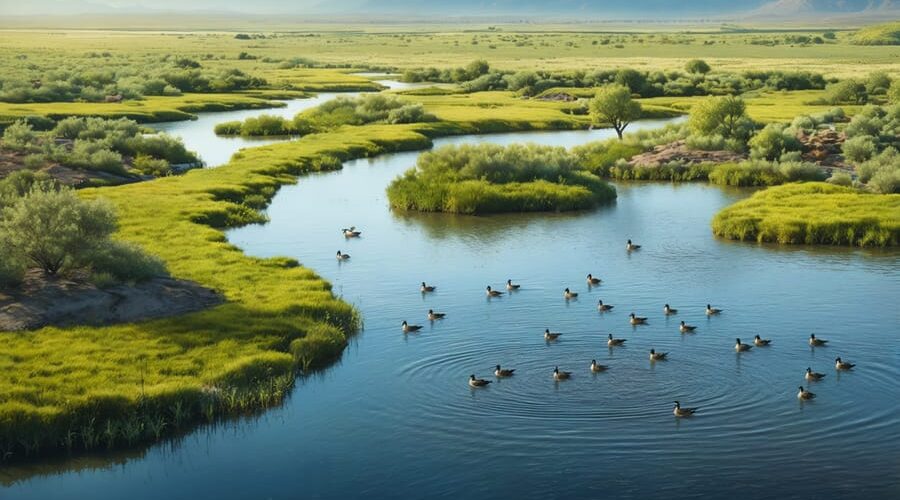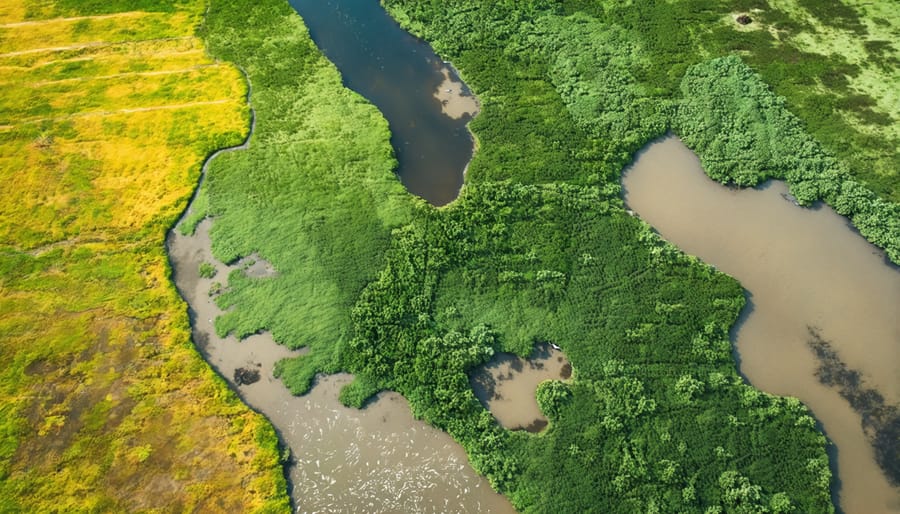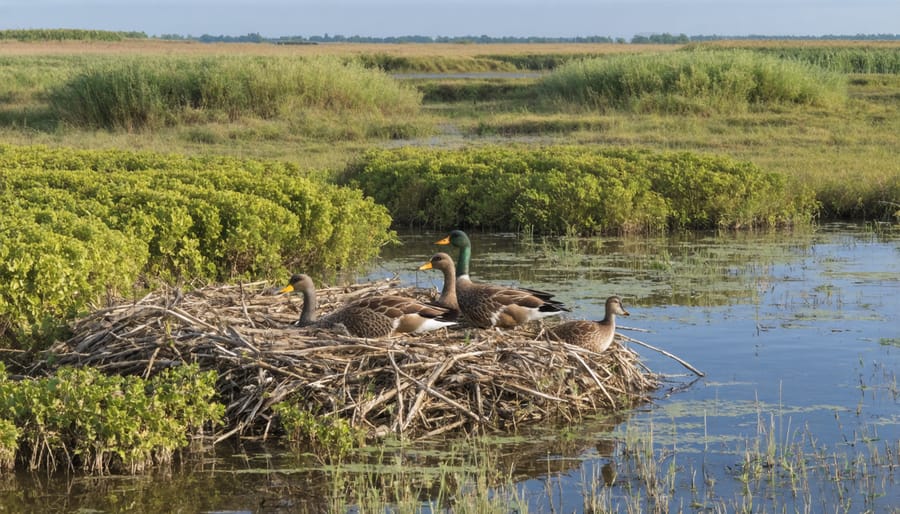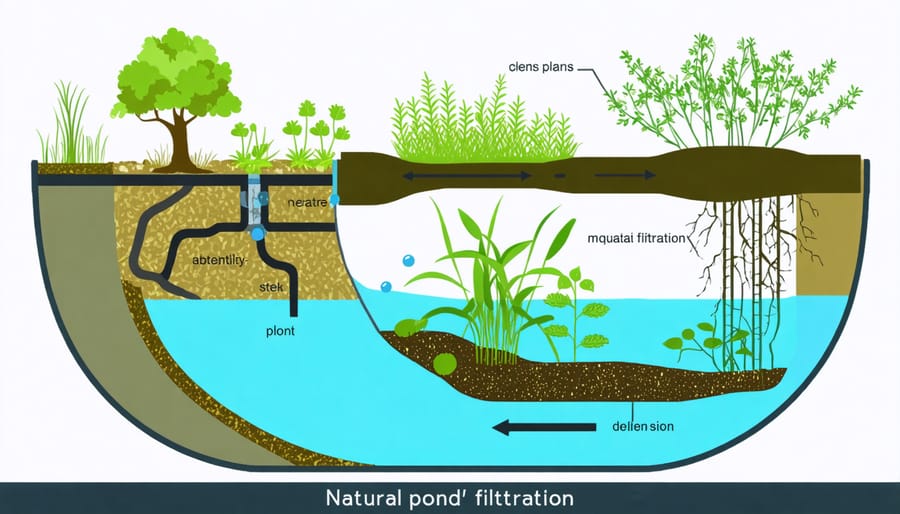
Transform Your Pond into a Thriving Waterfowl Haven: Lessons from Utah’s Management Areas
Transform natural wetlands into thriving waterfowl sanctuaries by implementing Utah’s proven management strategies in your private pond. Start by designing waterfowl ponds with gradually sloping banks and varying water depths from 6 inches to 4 feet, mimicking the successful layouts of Utah’s Bear River and Farmington Bay refuges. Establish three distinct vegetation zones: emergent plants like bulrush and cattail for nesting cover, submergent vegetation for food sources, and upland buffer zones with native grasses for protection. Control water levels seasonally – flooding in fall to attract migrating birds, maintaining winter depths of 18-24 inches to prevent freezing, and creating spring mudflats for foraging. These techniques, adapted from Utah’s 500,000+ acres of managed wetlands, have consistently supported diverse waterfowl populations and can be scaled effectively for private properties while maintaining essential habitat characteristics.
Essential Habitat Features of Utah’s Waterfowl Areas

Water Depth Zones
Creating diverse water depths is crucial for attracting different waterfowl species to your pond or water feature. Just like Utah’s successful management areas, your pond should include various zones ranging from very shallow to deeper waters.
Start with a shallow zone of 2-6 inches deep near the shoreline. This area is perfect for dabbling ducks like mallards and pintails, who love to forage in shallow waters for plants and invertebrates. These edges also provide essential resting areas for birds.
Include a mid-depth zone of 1-3 feet, which attracts a wider variety of waterfowl. This depth is ideal for birds like gadwalls and wigeons, who feed on submerged vegetation while keeping their feet within reach of the bottom. It’s also perfect for young ducklings learning to swim and feed.
Don’t forget to incorporate deeper sections of 4-6 feet. Diving ducks such as redheads and canvasbacks prefer these areas where they can completely submerge to feed on bottom-dwelling plants and organisms. These deeper zones also help maintain water temperature during extreme weather and provide refuge during winter months.
When designing your water zones, create gradual slopes between depth changes rather than sudden drops. This natural transition mimics wild habitats and allows birds to move easily between areas while feeding and resting. Remember to maintain these depths through regular monitoring and maintenance to keep your waterfowl habitat thriving.
Vegetation Management
In Utah’s waterfowl management areas, vegetation plays a crucial role in providing food, shelter, and nesting sites for various waterfowl species. The state’s wildlife managers carefully select and maintain aquatic plants for different depths to create optimal habitat conditions.
Managers focus on establishing diverse plant communities that include emergent vegetation like bulrushes and cattails along shorelines, submergent plants such as sago pondweed in deeper waters, and floating vegetation like duckweed on the water’s surface. This layered approach ensures year-round food availability and protection for waterfowl.
Regular maintenance involves controlling invasive species through mechanical removal and selective herbicide application when necessary. Native plant species are encouraged through seasonal drawdowns, which mimic natural water level fluctuations and promote seed germination.
Spring planting typically occurs after ice-off, while fall plantings help establish root systems before winter. Managers also maintain buffer zones of upland vegetation around wetland areas, creating essential nesting cover for various duck species.
For maximum benefit, vegetation density is carefully monitored and adjusted. Too much growth can limit waterfowl movement, while too little doesn’t provide adequate coverage. The goal is to maintain about 50% open water to 50% vegetation ratio in most management areas, creating an ideal balance for feeding, resting, and breeding activities.
Seasonal Management Techniques
Spring and Summer Care
Spring and summer mark crucial periods for waterfowl management areas in Utah, as these seasons host vital nesting and breeding activities. During this time, these areas transform into bustling nurseries for various waterfowl species, each displaying unique seasonal wildlife adaptations that make them perfectly suited to Utah’s diverse wetland habitats.
Management efforts during these months focus on maintaining optimal water levels to support nesting success. Ideal conditions include gradually flooding areas to create a mosaic of shallow water zones intermixed with dry nesting sites. This careful water management helps protect nests from predators while ensuring easy access to feeding areas for both adult birds and their offspring.
Vegetation management becomes especially important during the breeding season. Managers work to maintain a healthy mix of emergent plants like cattails and bulrushes, which provide essential cover for nesting birds. They also ensure there’s adequate open water for feeding and brood-rearing activities. Regular monitoring helps identify and remove invasive plants that might crowd out beneficial native species.
Another key aspect of spring and summer management involves predator control measures. While natural predation is part of the ecosystem, excessive predator pressure can significantly impact nesting success. Management areas often implement strategic fencing and other deterrents to protect vulnerable nesting sites.
Visitors to these areas during breeding season are encouraged to maintain appropriate distances from nesting sites and follow posted guidelines. Some areas may have restricted access during peak nesting periods to minimize disturbance to breeding pairs and their young. This temporary limitation helps ensure the next generation of waterfowl has the best chance of survival.
For those managing private ponds, these same principles can be applied on a smaller scale. Creating protected nesting areas, maintaining appropriate water levels, and managing vegetation can help attract and support breeding waterfowl on your property.

Fall and Winter Preparation
As temperatures drop and winter approaches, preparing your waterfowl management area becomes crucial for supporting both resident and migrating birds. Start by maintaining water levels slightly deeper than summer depths, typically around 18-24 inches, to prevent complete freezing and provide safe roosting areas.
Create windbreaks by strategically placing hay bales or temporary barriers along the northern edge of your pond. This helps waterfowl conserve energy during harsh weather and provides shelter from winter storms. Consider installing a pond aerator or de-icer to maintain some open water throughout freezing conditions, which is essential for waterfowl survival.
Food sources become particularly important during fall and winter months. Allow natural vegetation to grow taller during late summer, as these plants will provide both food and cover. Focus on maintaining stands of native grasses and sedges that produce nutritious seeds. If permitted in your area, consider planting winter wheat or other cold-hardy grains near the water’s edge.
Establish designated quiet zones where birds can rest undisturbed. Minimize human activity in these areas, especially during early morning and evening hours when waterfowl are most active. Remove any unnecessary equipment or structures that might attract predators or create obstacles for birds.
Keep shorelines clear of excess debris while leaving some natural cover intact. This balance helps waterfowl move easily between water and land while maintaining protective coverage. Monitor ice formation and break up any dangerous sharp edges that could harm birds.
Remember to check local regulations regarding supplemental feeding, as rules vary by location. If allowed, consider creating feeding stations away from the main water body to prevent water contamination and maintain better hygiene for the birds.
Regular monitoring helps ensure your preparations are effective. Watch for signs of overcrowding or resource depletion, and adjust your management strategies accordingly. This attentive approach helps create a sustainable winter refuge that benefits waterfowl throughout the challenging cold season.
Water Quality Management
Natural Filtration Systems
Natural filtration systems play a vital role in Utah’s waterfowl management areas, mimicking nature’s own water purification processes. These systems use a combination of native plants, beneficial bacteria, and strategic water flow to maintain healthy aquatic environments for waterfowl.
Cattails, bulrushes, and other aquatic plants serve as natural filters, removing excess nutrients and pollutants from the water. These plants also provide essential nesting materials and cover for various waterfowl species. In many Utah management areas, you’ll find carefully planned vegetation zones that create a filtering sequence as water moves through the wetland system.
Biological filtration also occurs through microscopic organisms that break down organic matter and maintain water quality. Managers encourage these beneficial bacteria by maintaining proper water depth and flow rates. This natural approach reduces the need for chemical treatments and creates a more sustainable ecosystem.
The shallow marshes in Utah’s management areas are designed with gradual slopes and varying depths, allowing water to move slowly through vegetation. This careful engineering helps trap sediments and filter water naturally. During migration seasons, these filtration zones become favorite spots for waterfowl to rest and feed, as they provide both clean water and abundant food sources.
For private pond owners, these natural filtration principles can be scaled down by incorporating native wetland plants and creating similar water flow patterns in smaller water features.

Water Level Control
In Utah’s waterfowl management areas, successful habitat maintenance relies heavily on water level management techniques that mimic natural wetland cycles. Throughout the year, water levels are carefully adjusted to support different wildlife needs and maintain healthy vegetation growth.
During spring migration, managers gradually increase water levels to create shallow feeding areas for arriving waterfowl. These areas, typically maintained at 6-18 inches deep, provide essential rest stops for tired birds and access to nutritious plant life. As summer approaches, some units are slowly drawn down to expose mudflats, encouraging the growth of natural food plants and creating perfect conditions for shore birds.
Fall brings another careful adjustment, with water levels raised again to welcome migrating waterfowl and provide hunting opportunities. Deeper pools (2-4 feet) are maintained in select areas to ensure open water remains available even during freezing conditions, while shallow areas continue to offer crucial feeding zones.
Winter management focuses on maintaining some open water where possible, though many areas naturally freeze over. This seasonal freezing actually helps manage invasive plant species and rejuvenates the wetland bottom, preparing it for the next spring cycle.
These natural-mimicking cycles have proven highly successful in Utah’s management areas, creating productive habitat that supports diverse wildlife populations while maintaining healthy wetland ecosystems.
Sustainable Practices for Long-term Success
Maintaining a thriving waterfowl habitat requires consistent attention and sustainable practices that work with nature rather than against it. The key is to establish a maintenance routine that supports both the immediate needs of waterfowl and the long-term health of the ecosystem.
Water level management plays a crucial role in sustainable habitat maintenance. Following Utah’s successful model, implementing a rotating schedule of drawdowns and refills helps prevent vegetation from becoming too dense or too sparse. This process typically involves lowering water levels in early spring to encourage plant growth, then gradually increasing levels as summer approaches to provide optimal feeding depths for waterfowl.
Vegetation management requires a balanced approach. Native plants should be encouraged while invasive species are controlled through targeted removal. Regular monitoring helps identify potential problems before they become overwhelming. Many Utah management areas use a combination of mechanical removal, careful herbicide application, and strategic flooding to maintain desired plant communities.
Predator management is another essential component of long-term success. Installing predator-resistant nesting structures and maintaining appropriate buffer zones around wetland areas helps protect vulnerable waterfowl populations. Regular monitoring of predator activity allows for timely adjustments to protection strategies.
Soil and water quality testing should be conducted seasonally to ensure optimal conditions for both plant growth and waterfowl health. This includes monitoring pH levels, nutrient content, and potential contaminants. When issues are detected, natural remediation methods should be prioritized over chemical solutions whenever possible.
Infrastructure maintenance, including water control structures, dikes, and paths, requires regular inspection and repair. Addressing small problems promptly prevents costly major repairs later and ensures consistent habitat quality. Establishing a maintenance calendar that aligns with seasonal waterfowl usage patterns helps optimize timing for various management activities.
Success in waterfowl habitat management comes from consistent observation and adaptive management. Keep detailed records of maintenance activities and their outcomes to refine practices over time. This data-driven approach helps create more effective and efficient management strategies for the future.
Utah’s waterfowl management areas offer invaluable lessons for pond owners and wildlife enthusiasts. By implementing similar strategies on a smaller scale, you can create thriving habitats that attract and support diverse waterfowl populations. Remember to focus on maintaining healthy water levels, establishing native vegetation, and creating protected nesting areas. Regular monitoring and seasonal maintenance are key to success, while responsible hunting practices help maintain balanced populations. Whether you’re managing a small backyard pond or larger private wetland, these proven techniques can help you develop a vibrant ecosystem that benefits both wildlife and human visitors. Start small, be patient, and watch as your efforts transform your water feature into a sanctuary for Utah’s magnificent waterfowl species.
